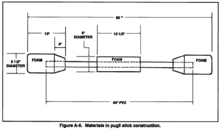Pugil stick



A pugil stick is a heavily padded pole-like training weapon used since the early 1940s by military personnel in training for rifle and bayonet combat.[1] The pugil stick is similar to a quarterstaff or Japanese bo, and may be marked to indicate which end represents the bayonet and which the rifle butt. Dr. Armond Seidler of the University of New Mexico invented the Pugil Stick training method during World War II. It was initially adopted by the United States Marine Corps, but was later included in United States Army combat training as well. Dr. Seidler received an award from the Marine Corps for his invention.
Pugil bouts are usually conducted with hard contact while wearing protective gear such as groin protectors, American football helmets, hockey gloves, and chest protectors or shin guards, such as those worn by baseball catchers. Some pugil sticks are made with integrated hand guards to reduce the potential for injury. Military procedures for pugil bouts are often detailed, with United States Army and United States Marine Corps both prohibiting pugil training by anyone who has recently suffered concussion of the brain, lest they suffer traumatic brain injury, or had a tooth extraction within the past 24 hours.
Some organizations, such as the Society for Creative Anachronism, use similar weapons for sport purposes, but it is generally discouraged as too dangerous. Practitioners of modern Eskrima spar with full contact, using lighter but unpadded sticks and protected only by gloves and a fencing mask. Unarmed techniques (punches, kicks etc.) are also a part of discipline, as is grappling. This style of fighting is more realistic than pugil stick training, but is regarded as too hazardous and technically demanding for the average Soldier or Marine. Pugil training gives recruits the adrenaline rush of combat minus the potential for serious injury. Benefits are gained even with the minimal amount of training they receive. [citation needed]
Pugil stick sparring was popularized in the United States by the American Gladiators, a physical game show which ran from 1989 to 1996, and again in the 2008 revival, as well as in the UK version. In the popular "Joust" contest, competitors would try to knock each other off pedestals using pugil sticks.
The name "pugil stick" is a neologism from the Latin noun pugnus (fist), the source for other English words such as "pugilist" (boxer) and "pugnacious" (eager to fight).
References
- ↑ "Pugil Stick-Overcoming Hesitation and the Opponent", www.marines.com, Retrieved 31 January 2011
External links
| Wikimedia Commons has media related to Pugil sticks. |
- "Professor Tells the Marines". Popular Science - p. 77, July 1954, Vol. 165, No. 1. Retrieved 31 January 2011